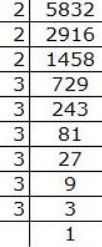Worksheet Solutions: A Square and A Cube | Mathematics (Maths) Class 8 PDF Download
Multiple Choice Questions
Q1: Cube root of the expression 1252(a) 5
(b) 25
(c) 10
(d) 125
Ans: (b)
1252=125×125
So, 3√1252= 3√5×5×5×5×5×5=25
Q2: Which of the following is not a perfect square number?
(a) 1156
(b) 4657
(c) 4624
(d) 7056
Ans: B)
A perfect square is a number that can be expressed as the square of an integer.
Check if each option is a perfect square:
- is not a perfect square (not an integer square root).
Q3: Which of these is not a perfect cube but a perfect square of a number
(a) 729
(b) 2197
(c) -1331
(d) 169
Ans: (d)
169= 13×13
Q4: Which of these is a perfect cube
(a) 216
(b) 392
(c) 8640
(d) 243
Ans: (a)
Q5: √0.09 is
(a) 0.3
(b) 0.03
(c) 0.9
(d) 0.33
Ans: A)
We need to find the square root of 0.09 by the long division method.
Square Root of 9 is 3.Further, we can do 3/10=0.3Thus square root of 0.09 is 0.3.
Q6: The sum of first n odd natural numbers is
(a) n2
(b) 2n
(c) n2+1
(d) n2−1
Ans: A)
The sum of the first n odd natural numbers is known to be n2.
Q7: The one’s digit of the cube of 53 is:
(a) 9
(b) 3
(c) 7
(d) 1
Ans: (c)
Q8: The volume of the cube is 5832m3 , the side is
(a) 18m
(b) 16 m
(c) 28 m
(d) 19m
Ans: (a)
Q9:A perfect square can never have the following digit in its ones place
(a) 8
(b) 4
(c) 0
(d) 1
Ans: A)
Sol: The last digit of a perfect square can be 0, 1, 4, 5, 6, or 9.
8 is not included in this list.
Q10: Which of the following expressions is not a perfect cube
(a) 27 x 125 x 64
(b) 1331 x 125 x 8
(c) 15 x 8 x 25 x 9
(d) None of these
Ans: (d)
A perfect cube is a number that can be expressed as the cube of an integer. Since all integers in options a, b,and c can be expressed as a cube of integers. Therefore, None of these is the answer.
True and False
Q1: 648 is not a perfect cube.Ans: True
Q2: 999 is a perfect cube.
Ans: False
Q3: The square of a number is positive, so the cube of that number will also be positive.
Ans: False
Q4: 125×8×27 is a perfect cube.
Ans: True
Q5: For an integer p, p3 is always greater than p2.
Ans: False
Q6: 83 = 5.12
Ans: False
Fill in the blanks
Q1: The square of an even number is _____
Ans: even
Sol: The square of an even number is always even.
Q2: The least number by which 72 be multiplied to make it a perfect cube is __________.
Ans: 3
Q3: √4096 is ____
Ans: 64
Q3: If 8x3=216, then x ix ____
Ans: 3
Q3: The cube of .5 is _____
Ans: .125
Q4: There are _________ perfect cubes between 1 and 1000.
Ans: 8
Q5: The digit at the ones place of 233 is ____
Ans: 7
Q6: The cube of the even natural number is ____
Ans: even
Find the cube roots by prime factorization method
Q1: 15625
Ans: 15625=5×5×5×5×5×5
3√15625=25
Q2: 2744
Ans: 2744=23×73
3√2744=2×7=14
Q3: 125/2197
Ans: 125/2197=(5x5x5)/(13×13×13)
3√125/2197=5/13
Q4: 5832
Ans: 5832= 2 x 2 x 2 x 3 x 3 x 3 x 3 x 3 x 3
3√5832=2×3×3=18
Q5: 64000
Ans: 64000 = 4 x 4 x 4 x 10 x 10 x 10
3√64000=4×10=40
Find the square roots by prime factorization method
Q1: 144
Ans: 144 = 2 × 2 × 2 × 2 × 3 × 3
Pairing: (2×2) (2×2) (3×3)
√144 = 2 × 2 × 3 = 12
Q2: 3600
Ans: 3600 = 2 × 2 × 2 × 2 × 3 × 3 × 5 × 5
Pairing: (2×2) (2×2) (3×3) (5×5)
√3600 = 2 × 2 × 3 × 5 = 60
Q3: 2025
Ans: 2025 = 3 × 3 × 3 × 3 × 5 × 5
Pairing: (3×3) (3×3) (5×5)
√2025 = 3 × 3 × 5 = 45
Q4: 81/256
Ans: 81/256 = (3 × 3 × 3 × 3) / (2 × 2 × 2 × 2 × 2 × 2 × 2 × 2)
Pairing numerator: (3×3) (3×3) → gives 3 × 3
Pairing denominator: four pairs of (2×2) → gives 2 × 2 × 2 × 2
√(81/256) = (3 × 3) / (2 × 2 × 2 × 2) = 9/16
Q5: 1024
Ans: 1024 = 2 × 2 × 2 × 2 × 2 × 2 × 2 × 2 × 2 × 2 (ten 2s)
Pairing: five pairs of (2×2)
√1024 = 2 × 2 × 2 × 2 × 2 = 32
Q6: 3844
Ans: 3844 = 2 × 2 × 31 × 31
Pairing: (2×2) (31×31)
√3844 = 2 × 31 = 62
Answer the following questions
Q1: Is 256 a perfect cube? If not, find the smallest number by which it should be divided to get a perfect cube.
Ans: 256=28=23×23×22
Therefore, it is not a perfect cube
So, it must be divided by 4 to become a perfect cube
Q2: What could be the possible ‘one’s’ digits of the square root of each of the following numbers?
(i) 1801
(ii) 856
(iii) 1008001
(iv) 6577525
Ans: (i) Last digit is 1 , So one digit can be 1 or 9 as 12=1 and 92=81
(ii) Last digit is 5 , So one digit can be 4 or 6 as 42=164 and 62=36
(iii) Last digit is 1 , So one digit can be 1 or 9 as 12=1 =1 and 92=81
(iv) Last digit is 5 , So one digit will be 5 as 52=25
Q3: Three numbers are in the ratio 1:2:3 and the sum of their cubes is 4500. Find the numbers.
Ans: Let the number be x,2x,3x
Now
x3+8x3+27x3=4500
36x3=4500
x3=4500/36
x3=125
x=5
So the numbers are 5,10,15
Q4: Find the smallest number by which following number must be divided to get a perfect square. Also, find the square root of the perfect square so obtained.
(i)600
(ii)2904
Ans: (i) 600= 2 x 2 x 2 x 3 x 5 x 5
We can see numbers 2 and 3 is not in pairs, So to make a perfect square, it has to be divided by 6
Then number will become=100
Now
100= 2 x 2 x 5 x 5
√100=2×5=10
(ii)2904=2 x 2 x 2 x 3 x 11 x 11
We can see number 2 and 3 is not in pair, So to make a perfect square, it has to be divided by 6
Then number will become=484
Now
484= 2 x 2 x 11 x 11
√484=2×11=22
Q5: Find the smallest number by which following number must be multiplied to get a perfect square. Also, find the square root of the perfect square so obtained.
(i) 1008
(ii) 1280
(iii) 1875
Ans:
(i)1008= 2 x 2 x 2 x 2 x 3 x 3 x 7
We can see number 7 is not in pair, So to make a perfect square, it has to be multiplied by 7
Then number will become=7056
Now
7056= 2 x 2 x 2 x 2 x 3 x 3 x 7 x 7
√7056=2×2×3×7=84
(ii)1280=2 x 2 x 2 x 2 x 2 x 2 x 2 x 2 x 5
We can see number 5 is not in pair, So to make a perfect square, it has to be multiplied by 5
Then number will become=6400
Now
6400= 2 x 2 x 2 x 2 x 2 x 2 x 2 x 2 x 5 x 5
√6400=2×2×2×2×5=80
(iii)1875= 3 x 5 x 5 x 5 x 5
We can see number 3 is not in pair, So to make a perfect square, it has to be multiplied by 3
Then number will become=5625
Now
5625= 3 x 3 x 5 x 5 x 5 x 5
√5625=3×5×5=75
|
113 videos|630 docs|42 tests
|
FAQs on Worksheet Solutions: A Square and A Cube - Mathematics (Maths) Class 8
| 1. What are the basic differences between a square and a cube in mathematics? |  |
| 2. How can I find the cube roots of a number using the prime factorization method? |  |
| 3. What is the significance of learning about squares and cubes in Class 8 mathematics? |  |
| 4. Are there any specific formulas to remember for squares and cubes? |  |
| 5. How can understanding squares and cubes help in higher-level mathematics? |  |




















